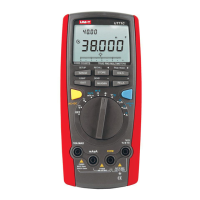
Do you have a question about the UNI-T UT71C and is the answer not in the manual?
| Type | Digital Multimeter |
|---|---|
| Diode Test | Yes |
| Continuity Test | Yes |
| Data Hold | Yes |
| Auto Power Off | Yes |
| Power Supply | 9V Battery |
| Frequency Range | 10Hz to 10MHz |
| Temperature Range | -40°C to 1000°C |
General introduction to the manual and the multimeter's capabilities and safety precautions.
Instructions for checking package contents to ensure no items are missing or damaged.
Essential safety guidelines, including warnings and notes for hazard identification.
Specific rules to follow to avoid electric shock, personal injury, or equipment damage.
Explanation of international electrical symbols used in the manual and on the meter.
Procedure for powering on the multimeter by turning the rotary switch.
Information about the 9V battery type and techniques for conserving battery power.
Details on the meter's automatic power off feature and its configurable timing.
Explanation of the automatic backlight turn-off feature and its settings.
How the meter indicates a low battery and the importance of replacing batteries promptly.
Diagram illustrating the meter's main components like display, buttons, and terminals.
Guide to using the rotary switch to select measurement functions and alternate functions.
Description of various buttons and their primary and secondary functions.
Cross-reference table showing meter functions and their corresponding primary/secondary displays.
How to select between autoranging and manual ranging for measurements.
Explanation of display features, icons, and their meanings.
Step-by-step guide for measuring AC and DC voltages with safety precautions.
Procedure for measuring AC and DC currents, including fuse checks and connection methods.
Instructions for measuring resistance, including safety and connection details.
How to perform continuity tests using the meter, including buzzer indication.
Procedure for testing diodes and semiconductor junctions, including voltage drop interpretation.
Guide for measuring capacitance, including discharge procedures and accuracy tips.
How to measure frequency and duty cycle, with input amplitude requirements.
Instructions for measuring temperature using the K-Type probe and unit selection.
How to use the 4-20mA loop feature to display readings as a percentage.
Procedure for measuring power, including voltage and current input requirements.
How to store measurement readings, manage the interval, and clear stored data.
Procedure to recall previously stored measurement values from memory.
Instructions for exporting stored data to a computer via USB using the Send feature.
How to enter Setup mode and change configuration options like auto power off and backlight.
Basic maintenance procedures including cleaning the case and terminals.
Step-by-step guide for safely replacing the internal fuses.
Instructions for replacing the 9V battery, emphasizing safety during the process.
Details on safety standards, certifications, and fused protection for input terminals.
Information on the meter's dimensions, weight, display resolution, and operating environment.
General operational specifications including range, polarity, overloading, and battery deficiency.
A concise summary of the multimeter's key features and capabilities.
Core technical specifications for various measurement functions like voltage, current, and resistance.
In-depth accuracy data for each measurement range, including resolution and overload protection.